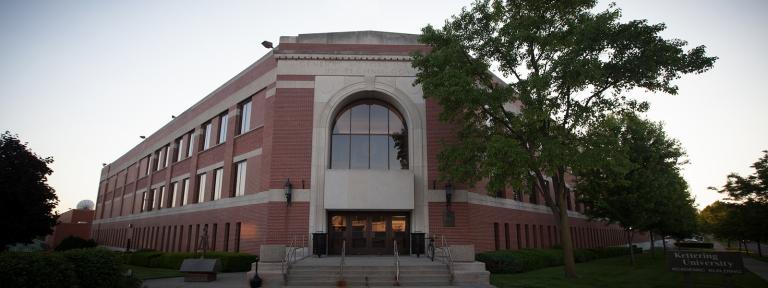
“As humans, we can easily tell where we are. We don’t even think about it when we go place to place. For robots, that’s a big challenge for them to know where they are at.”
Collaboration is fueling innovation at Kettering University as five faculty members combined their research efforts to garner an $114,039 grant from the National Science Foundation (NSF).
Justin Young (principle investigator), Terri Lynch-Caris, Mehrdad Zadeh, Girma Tewolde and Giuseppe Turini co-sponsored a program entitled "MRI: Acquisition of a Motion Capture System to Facilitate Multidisciplinary Research Efforts and Enhance Undergraduate Research Training."
“We really did have potential for collaboration and that really strengthens these proposals to the NSF,” Young said. “Most of the investigators on this proposal are assistant professors. By establishing these partnerships, it’s going to foster a sense of community and teamwork. We can attack these larger research projects and it’s not going to fall on a single faculty member. “
The grant will allow for the acquisition of a three position sensor 3D Investigator Motion Capture System by Northern Digital Inc. This instrument acquisition will serve faculty researchers from the Industrial and Manufacturing Engineering (IME), Computer Science (CS), and Electrical & Computer Engineering (ECE) departments (see Table 1). Their overlapping research specialties include ergonomics, human factors, human-computer interaction (HCI), haptic interfaces, virtual reality and simulation environments, medical robotics, and autonomous vehicle navigation.
“One of the most unique things about this grant is that it’s going to bring multi-disciplines together,” Lynch-Caris said. “How this one piece of equipment will be used by Computer Science and ECE is different from how it can be used in Industrial Engineering. Within Work Design, it can be used to measure productivity in both manufacturing and office environments. Some of the most exciting research ideas happen at the intersection of disciplines.”
Justin Young
By attaching a set of motion-capturing markers to an individual, the equipment can provide the known location of joints and bones in order to build muscular models and make precise measurements of motion when interacting with the physical environment. Young’s research focuses on biomechanics and ergonomics and the equipment will help him determine how individuals’ motions are impacted by surrounding technologies.
Lynch-Caris will focus her efforts solely on ergonomics and measuring worker productivity and posture on computer tasks with varying degrees of difficulty.
Terri Lynch-Caris
In addition studying how humans interact with their work environment, the equipment can also be used for the development of robot technologies. Tewolde is working on helping robots determine their physical location indoors.
“As humans, we can easily tell where we are. We don’t even think about it when we go place to place. For robots, that’s a big challenge for them to know where they are at,” Tewolde said. “For outdoor applications, you can easily use a GPS to localize and navigate but for indoors, the signals are very weak. So some of the work I’ve done in this area is determining how we can utilize existing infrastructure like Wifi access nodes as reference points. I’d like to evolve the activity and the quality of results gained from this localization.”
Mehrdad Zadeh
The newly acquired equipment will help track the motion of robots in indoor environments which can potentially lead to solutions for the directional challenges that robots currently encounter. The practical application of this technology would be self-reliant robots being used for household services, services for the elderly, patient care in hospitals and cleaning tasks in large public spaces like airports and shopping malls.
Apart from faculty and student research the equipment will also be used as a community education platform for Flint-area students. The faculty will create science learning modules that utilize the new equipment, which is similar to that used to make video games and animated major-motion pictures to expose students to the possibilities of technology in their community.
Girma Tewolde
“If we can put a module together where students can see what we are doing when they come in and get exposed to this high tech equipment then hopefully we can get more students interested in science and math and hopefully they come to Kettering,” Young said.
Lynch specifically feels that this program will enhance Kettering’s Lives Improve Through Engineering (LITE) program that hosts female scholars interested in science and math on campus each summer. Lynch feels that the equipment and corresponding modules “will do a lot to get females to try engineering.”
Giuseppe Turini
“It will be great to have such an instrument on campus at Kettering,” Zadeh said. “It helps student retention and student enrollment. When students and parents will see such activity, it will be more attractive for them to choose Kettering over other choices. It’s also very good for extending STEM.”
Table 1: List of faculty members at Kettering University collaborating on the MRI Grant from the National Science Foundation and their research interests.
Justin Young - Ergonomics, Safety, HCI
Giuseppe Turini - Virtual reality & surgical simulation
Mehrdad Zadeh - Haptics, HCI, Tele-robotics
Terri Lynch-Caris - Ergonomics, Engineering Education
Girma Tewolde - Autonomous systems